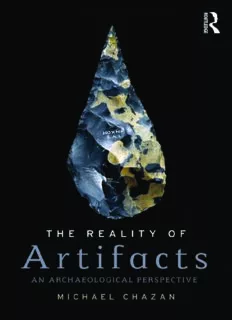
The Reality of Artifacts: A Perspective from the Archaeology of Human Evolution PDF
Preview The Reality of Artifacts: A Perspective from the Archaeology of Human Evolution
THE REALITY OF ARTIFACTS Artifacts are hybrids, both natural and cultural. They are also an essential component in the process of human evolution. In recent years, a wide range of disciplines, including cognitive science, sociology, art history, and anthropology, have all grappled with the nature of artifacts, leading to the emergence of a renewed interdisciplinary focus on material culture. The Reality of Artifacts: An Archaeological Perspective develops an argument for artifact as a status conferred by human engagement with material. On this basis, artifacts are considered first in terms of their relationship to concepts and cognitive functions, and then to the physical body and sense of self. The book builds on and incorporates the latest developments in archaeological research, particularly from the archaeology of human evolution, and integrates this wealth of new archaeological data with new research in fields such as cognitive science, haptics, and material culture studies. Making the latest research available for the general reader interested in material culture, while also providing archaeologists with new theoretical perspectives built on a synthesis of interdisciplinary research, the book is suitable for courses taught at both the graduate and undergraduate level, and is broadly accessible. Michael Chazan is a Professor in the Department of Anthropology at the University of Toronto. He co-directs the Wonderwerk Cave Research Project with fieldwork at Wonderwerk Cave and the sites of the Kathu Complex, both located in the Northern Cape province of South Africa. THE REALITY OF ARTIFACTS An Archaeological Perspective Michael Chazan First published 2019 by Routledge 2 Park Square, Milton Park, Abingdon, Oxon OX14 4RN and by Routledge 711 Third Avenue, New York, NY 10017 Routledge is an imprint of the Taylor & Francis Group, an informa business 2019 Michael Chazan The right of Michael Chazan to be identified as author of this work has been asserted by him in accordance with sections 77 and 78 of the Copyright, Designs and Patents Act 1988. All rights reserved. No part of this book may be reprinted or reproduced or utilised in any form or by any electronic, mechanical, or other means, now known or hereafter invented, including photocopying and recording, or in any information storage or retrieval system, without permission in writing from the publishers. Trademark notice: Product or corporate names may be trademarks or registered trademarks, and are used only for identification and explanation without intent to infringe. British Library Cataloguing-in-Publication Data A catalogue record for this book is available from the British Library Library of Congress Cataloging-in-Publication Data A catalog record has been requested for this book ISBN: 978-1-138-21780-5 (hbk) ISBN: 978-1-138-63577-7 (pbk) ISBN: 978-1-315-43928-0 (ebk) Typeset in Bembo by Swales & Willis Ltd, Exeter, Devon, UK For my parents Robert and Saralea Chazan CONTENTS List of figures viii Acknowledgments x Introduction: defining artifacts 1 1 It is all in the mind 18 2 Artifacts and the body 46 3 Making space for the invisible 75 4 Wrapping the surface, rethinking art 96 5 The autonomy of objects 120 Epilogue: towards an ecology with objects 139 Index 143 FIGURES I.1 A flake and the core it was removed from showing the bulb of percussion 3 I.2 Stone tools from Evron Quarry 4 I.3 The face of the plastered skull from the Neolithic site of Kefar Hahoresh, Israel 8 I.4 Clay figurines from the temple at Motza 14 1.1 A plate of handaxes from Musée Préhistorique 19 1.2 A bedja bowl from excavations on the Giza Plateau 21 1.3 Levallois flake and core 25 1.4 Scraper types based on the Bordes typology 27 1.5 Technical criteria for the Levallois method 31 1.6 Two views of Pueblo potter Santana Martinez at work 39 2.1 A chopper characteristic of the earliest stone tool assemblages 55 2.2 The earliest known handaxes from the site of Kokiselei, Kenya 56 2.3 The early spears from Schöningen 58 2.4 Impact fracture at the end of one of the Kathu Pan 1 points 59 2.5 Retouched bladelets from the Aurignacian site of La Ferrassie 62 2.6 Metal-tipped San arrowheads from Botswana 66 2.7 The Zoninus collar 68 3.1 Sequence of flake removal from one of the refit cores from Lokalalei 82 3.2 Menas flasks 85 3.3 In situ evidence of fire from Wonderwerk Cave 88 3.4 Carved sandstone lamp from the Upper Paleolithic painted cave of Lascaux 90 Figures ix 4.1 View from the back of Wonderwerk Cave with the afternoon sun filtering in 100 4.2 Incised specularite cobble from Wonderwerk Cave, Excavation 6 102 4.3 Quartzite handaxe from the Sima de los Huesos, Atapuerca, Spain 104 4.4 The incised ochre from Blombos 107 4.5 The female figurine from Hohle Fels, Germany 111 4.6 Figurine of a mammoth from Vogelherd, Germany 112 4.7 Glass lamp from the mosque of Sultan Abu Said Barquq (1382–1399) 116 5.1 Minkondi figure of Mangaaka, the force of jurisprudence 121 5.2 Handaxes representing development through the Wonderwerk Cave sequence 124 5.3 Mycenaean stirrup jar 126 5.4 Excavation of huts at the Epipaleolithic site of Kharaneh IV 129 5.5 An aerial view of the dense network of architecture excavated at the Neolithic site of Ba’ja, Jordan 131 5.6 Figures of animated artifacts from the revolt of the objects 135
Description: